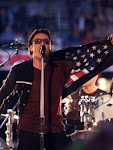
Look at the picture to the side: what does it represent to you?
This is a depiction of newly-elected President Andrew "Old Hickory" Jackson's inaugural party at the White House in 1829. The nation's capital had never seen such an event: thousands of people gathered in Washington, DC, to celebrate Andy's victory because, after all, they had received an invitation from the "People's Champion" himself! Most of them finally converged at the White House, compelling Jackson to sneak out the back door while his constituency offended their fellow more elitist party-goers, broke (or stole) the White House china and silverware, and consumed vast amounts of celebratory cider and punch. It was obvious to all observors that politics, and America itself, had changed...if not for the better, than at least for good. After all, as Jackson's detractors would sneer, would you ever see President Washington or John Adams presiding over such a scene?
For the next several days, we're going to take a look at how American politics changed as a result of the War of 1812 (otherwise known as the Second War for American Independence) and the rise of the Jacksonians. Also key to this study will be the impact of the United States' early westward expansion on the native Americans that lived on the American frontier. Your assignments for the next several days will be:
1.) Watch the presentations for Monterey Institute, Unit 3, Ch. 7-8, Lessons 20-22
a.) Lesson 20 - "The Louisiana Purchase" - Consider This - Were President Jefferson's responses to the Barbary pirates and the opportunity to buy the Louisiana Territory in harmony or conflict with his philosophy of Jeffersonian democracy?
b.) Lesson 20 - "The Aaron Burr Conspiracy" - Consider This - How did Aaron Burr's fateful duel with Alexander Hamilton affect political strategies of the early 1800s? What did Burr lose and/or gain politically?
c.) Lesson 21 - "Jefferson's Embargo" - Consider This - How did the Embargo & Non-Intercourse Acts support or challenge President Jefferson's political beliefs?
-These questions and answers are due on Mon., 10/17.
2.) Watch the presentations for Monterey Institute, Unit 3, Chapter 9, Lessons 26-29
a.) Lesson 26 - "The Election of 1828" - Consider This - The states of Virginia and Maryland were the last to adopt universal manhood suffrage. What characteristics do you think caused them to wait?
b.) Lesson 27 - "The Tariff of 1828" - Consider This - What other actions did President Jackson take that his opponents considered were outside of the authority of the presidency?
c.) Lesson 28 - "19th Century Banking" - Consider This - If the charter for the 2nd Bank of the United States had been renewed, how do you think it would have influenced the development of the West?
d.) Lesson 29 - "The Indian Removal Act" - Consider This - If Jackson had NOT been successful in carrying out his plan of Indian Removal, do you think the eastern states would have remained ethnically multiracial instead of biracial? What implications might that have had during the Civil War era?
-These questions and answers are due on Tues., 10/18.
3.) "American Pageant" Guidebooks, Ch. 12-13 - Due by Wed., 10/19
4.) "American Pageant", Ch. 12-13 Short-Response Questions (on my McKeel webpage) - don't wait until the last minute!! There are 48...
-Due Thurs., 10/20
4.) Zinn's "People's History", Ch. 7 - "As Long As the Grass Grows and the Water Runs"
a.) In 3-to-5 paragraphs, briefly summarize the chapter. Be sure to include the following words/terms, and highlight where you use them: Indian Removal, Tecumseh, Andrew Jackson, Creeks, Cherokee, Sam Worcester, Assimilation
b.) Answer the following:
1.) Explain why the United States treated natives in the manner they did. (3 to 5 paragraphs)
2.) Is there any parallel between Bacon’s Rebellion and the Indian wars preceding the War of 1812, with respect to the dynamics among the Indians, poor whites, and rich whites? If so, explain how the situations are parallel. If not, what factors are different enough so that there is no structural parallel? (3 to 4 paragraphs)
-Due Friday, 10/21

1 comment:
Post a Comment